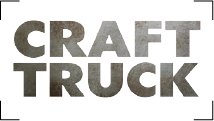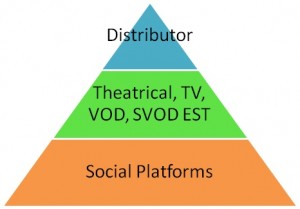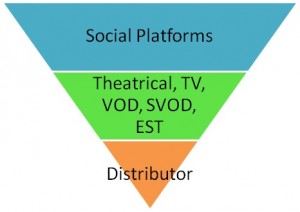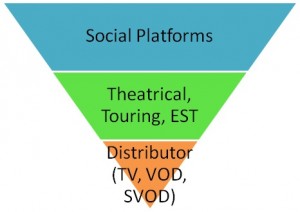What is a platform?:
A platform is anything that “you”, the creative author, stands on to be heard.
In this context “author” might literally mean writer, but it can also mean just about anything else – be it a director, an editor, a music composer – the author is the creative force.
The obvious platforms are Facebook, Twitter, Instagram, (insert social media “platform” of your choice here); it also means your own personal blog, Kickstart or IndieGoGo campaign.
Distributing your film on the bigger platforms would be Netflix, Amazon and iTunes, among others. These are the mega platforms in the industry. They are the means of distribution. And the way you choose spread your content is a wily circus of opportunity.
The democratization of media and distribution has given the creative producer a means to create and the the ability to push media to the end consumer.
This is the platform economy.
It’s the ability to take your message and deliver it via your chosen platform(s) to the people who are interested in hearing about what you have to say.
1. The Content Pie:
Consider this: as an author, you have just written your first book or novel. You walk into the publishers office and they say to you: “it’s great, what’s your platform?”. What they are really saying to you is, “how can YOU help ME, market YOUR book?”
Content is no longer enough. It’s not enough to have a great piece of art. It’s more important to have a platform so that you can get your message out.
As Steven Soderbergh said in his State of Cinema address:
In 2003, 455 films were released. 275 of those were independent, 180 were studio films. Last year 677 films were released. So you’re not imagining things, there are a lot of movies that open every weekend. 549 of those were independent, 128 were studio films. So, a 100% increase in independent films, and a 28% drop in studio films, and yet, ten years ago: Studio market share 69%, last year 76%. You’ve got fewer studio movies now taking up a bigger piece of the pie and you’ve got twice as many independent films scrambling for a smaller piece of the pie.- Steve Soderbergh
The base is getting wider. What this translates to is that you are working harder for a smaller piece of the pie…
…IF, you believe the pie is a fixed.
Are these independent films trying to compete for the same audience or are they able to dive deeper into niche audiences. Audiences that can be fostered and created where there wasn’t one before. The idea that the pie is only so big is just plain wrong.
The pie just keeps growing and expanding and spilling over the edges. It crosses over and overlaps. And it’s the creators job, now more than ever, to make their own pie.
Why do you think Kevin Smith takes his film on a road show? Now, admittedly, Kevin Smith is a very specific example, sure. But, it’s not like the idea is Kevin’s alone. Directors of niche audiences travel with their films all the time. They bootstrap their films across the country. Creating awareness and a platform for their film. They spread the idea and market their film.
Major and indie distributors have a finite amount of product that they can acquire in any given year. When times are bad – as they were not too long ago – the market shrinks. The big Sundance deals that everyone had coveted were gone. Or at least substantially smaller. Now, the market is back’ish.
For those chasing the dragon of the distribution deal.
For those who have worked tirelessly on that investor proposal banking on making a deal…
…at some point, the penny drops. There isn’t enough money to buy the next film. And what if the next film is an amazing movie.
What if every distributor passes on the next film? Not because it isn’t great and can’t find an audience, but because it was next in line and the ride is full.
Is the film dead? Is YOUR film dead? Oh well, we tried. The film premiered at Sundance, everyone had a few drinks; came really close to a deal with a major distributor, but it didn’t get picked up. Sorry. Onto the next.
No. The film isn’t dead. The film is only as alive as the platform for which you, the creator, the independent author, the driving creative force of the film – can push your product onto.
2. Building Your Platform:
If you haven’t read the production story about Indie Game, you should. It’s a great story. It’s inspiring. And it’s one of many self made distribution models. They built their own platform. Distributed the movie on both regular channels and in-person touring. Sure, they had some festival love (winning several major awards) to kick start things… but like many projects, it started with crowdsourcing but didn’t stop there.
Traditionally, the platform of olden days for a book author was to sell to a publisher and then sit back and let them do all the work. You sold your book to a publish, pop open the bubbly, it’s time to celebrate.
In the film business, you bring your film to a major festival, it sells to a major distributor; time for Champaign. That’s no longer the case. Or, if it is still the case, it’s only so for a fractionally smaller segment of the films. Now what…?
The platform is what you stand on. And you can stand on anything — but more to the point, you should stand on everything.
Because the platform isn’t just your blog. It’s not just your Twitter feed or Tumblr. It’s not simply Amazon, or Hulu, or Netlfix or iTunes. Its everything. Your job is to be in as many places as your customer can find you.
Today’s world is getting cluttered. Fast. It’s becoming harder and harder to break through to an audience. Any audience. But that doesn’t mean you can’t start today to build your space(s) where you will be heard.
Ultimately, a strong marketing strategy is more important that the content strategy. Now, that’s arguable, sure. But there are great films every year that get produced that don’t see the light of day… so before you start, its worth taking the time to think and build your marketing strategy.
[NOTE: this isn’t intended to mean that you should produce or create schlock and just focus on the marketing and selling; the underlying assumption is that you care. That every creator is passionate about what they do. And while not all content is created equal, the assumption is that we all want to produce great content… end of rant].If you haven’t seen a typical film business plan, they all look the same. They say “this movie is like that movie; that movie made such and such at the box office; so investor, you can hope to make $X at the box office”.
And the marketing plan looks like this, “This product would fit well with distributor X,Y or Z, all of which have done very well with this kind of product; you can expect for it to sell for this much coming out of a film festival”. Absurd. Absolutely absurd.
The idea that your film should track next to (insert indie hit here); and the notion that because other distributors have picked up “these” kinds of films before for “that” kind money is absolutely insane. Yet, for some reason, we still cling that notion.
3. Flip the Pyramid
Producers and content creators need to inverse pyramid. The economics of the business should be completely flipped. And, then, and only then, if the economics can still stand the weight of the investment should one proceed to make the film.
Lets take a closer look.
The traditional model looks like this — distributor at the top of the period. They stand to make the most amount of money and they hold all the rights below them (in the pyramid). When you sell to a distributor (in an all rights deal), you sell off your theatrical rights, your TV rights, your Video-On-Demand (VOD) rights, your Subscription-On-Demand-Rights (SVOD – think Netflix or your pay cable provider), your Electronic Sell-Through (EST, think iTunes) and on and on down the line.
Now, lets flip the pyramid and see what that looks like…
Now we have the distributor at the bottom and you at the top. Theatrical, TV, VOD, SVOD, Touring, etc. — the point is that you are at the top and control all the rights and the distributor is at the bottom.
This is what the new model of distribution looks like.
Now lets be clear about a few points here. First, the assumption is that you could actually distribute your film into theatres. Or, that you could get your film on Netlfix. Or, that you could sell your film to TV.
These are all big assumptions. And there’s a reason why distributors do what they do. It’s not easy. It’s not easy to book a theatre or sell to a tv station or to get product onto iTunes (in fact, if you are not an approved provider of content, you actually can’t get your product onto iTunes)…
… but there are options. There are ways to get your film into theatres. There are ways to work with a myriad of aggregators that can help you get your film on iTunes or Amazon or onto any of these other platforms. There’s now more options than there ever were to work your way through the value chain and get your product to the costumer.
So, maybe, YOUR triangle looks more like this:
The point is that you now have to juggle this complex maze to figure out what will work best for you and your film.
The above illustrates one fundamental point… that the majority of films will end up in this boat. And that if this is your boat, you better know how to navigate the waters. And if you can’t navigate the water — DON’T SET SAIL; or at at the very least, be prepared for a storm. How’s that for a compound metaphor?
At least from a purely investor relations strategy – if you are Director and have $50K to spend on yourself because you want to pick up a camera – then go for it – but it would still be wise to do so with a strategy for getting the film out there. Because if it’s not purely for self-eduction. If you want your film to be seen — then it’s wise to think about your film at the intersection of art and commerce.
At some point, $10,000 turns into $100,000 which turns into $1 million which turns into $X million. But at all points in the chain, the analysis should be same. How will you get people to see your movie? And in so doing, can the economics of getting people to see you movie pay off for you in the form of a return on investment.
And hence the inverse pyramid.
Your efforts to build and create your platform is your audience. That’s the people who want to see your film because you have cultivated a relationship with them.
And if your investment proposal doesn’t factor this in, maybe you shouldn’t start. If you haven’t thought about how you are going to return money to your investor (even if that investor is YOU), maybe it’s not something you should be doing.
The platform economy is about finding an audience. Cultivating an audience. And if you can do that BEFORE you push that little red button, all the better.
How do YOU think about the new economy and film distribution? We’d love to hear your response in the comment section below!
Looking forward to reading your answers. 🙂
Did you enjoy this post? Want more like it – get free updates.




